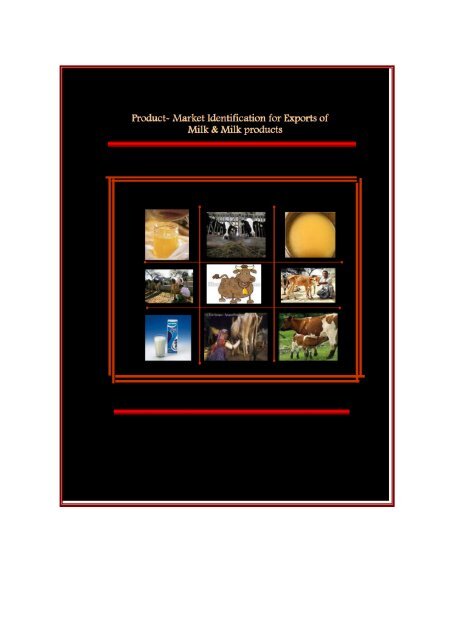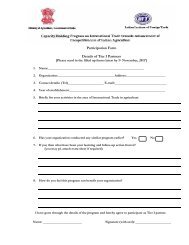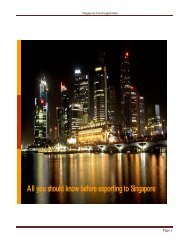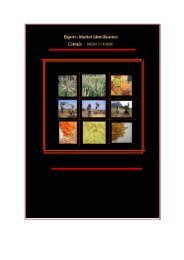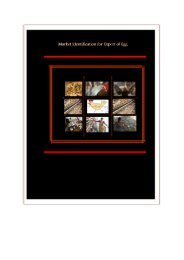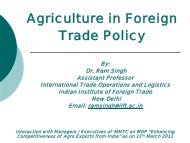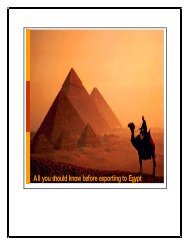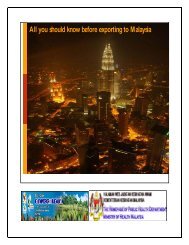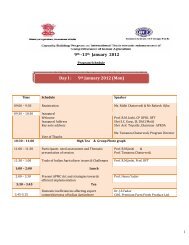Milk & Milk Products
Milk & Milk Products
Milk & Milk Products
Create successful ePaper yourself
Turn your PDF publications into a flip-book with our unique Google optimized e-Paper software.
Introduction<br />
Dairy sector is the single largest contributor of agricultural sector to India’s gross domestic<br />
product, with its annual value exceeding Rs. 100,000 crores. India has emerged as the largest milk<br />
producer in the world, accounting for more than 14 per cent of the world and 57 per cent of Asia’s<br />
total production. State of Andhra Pradesh is one of the largest milk producing state of the country<br />
having one of the largest buffalo population which is endowed with unique processing<br />
qualities.Buffalo milk is creamier, whiter, and richer in fat, SNF, minerals like Ca and P, besides<br />
possessing relatively higher levels of physiologically significant bio-immune and extranutritional<br />
factors. These unique processing attributes render buffalo milk especially suitable for<br />
commercially important dairy products such as Mozzarella cheese, cream, butter, dairy whiteners,<br />
paneer, khoya, etc.<br />
This enables AP as the leading supplier of these products in the world market. Hence the dairy<br />
industry of the state can derive maximum benefits of the uniqueness and positive virtues of<br />
buffalo milk to obtain the competitive edge in the global dairy market. Moreover AP is<br />
strategically located in India having an easy access to all parts of the country and also to<br />
perennially milk deficit countries in South East Asia and Australia. Major importers of milk and<br />
milk products are Bangladesh, China, Hong Kong, Singapore, Thailand, Malaysia, Philippines,<br />
Japan, UAE, Oman, and other Gulf countries located in close proximity to India.<br />
Also, economic growth and changes in dietary preferences in the Southeast Asian countries have<br />
stimulated consumption of dairy products, even though it is not a part of their traditional diets.<br />
Growth of quick service restaurants (QSRs), particularly pizza chains, and growing bakeries and<br />
other food processing industries also increase the demand for cheese and other dairy products.<br />
Andhra Pradesh, thus, enjoys a strategically advantageous geographical location in terms of<br />
international trade of dairy products.<br />
Global opportunities available to the dairy industry of the state also arise primarily out of the<br />
availability of a large quantity of competitively priced milk. As the Indian dairy sector produces<br />
milk without any subsidies, the country stands to gain from the fair implementation of WTO<br />
agreements. India needs to prepare itself to access the markets of developed countries such as the<br />
29
European Union, USA and Japan, and has already an edge with regard to the deficit regions of<br />
South and Southeast Asia, Middle East and Africa for supply of dairy products at competitive<br />
price. However, quality of milk produced in the state falls below the internationally accepted<br />
standards. Development of awareness, mindset and commitment on improving the quality of milk<br />
is necessary. Intensive efforts are needed to meet the WTO’s Sanitary and Phytosanitary (SPS) and<br />
Technical Barriers of Trade (TBT) agreements and Codex Alimentarius Commission guidelines on<br />
quality and safety.<br />
In order to propel the export of milk and milk products, there is an urgent need to discuss and<br />
institutionalise the various provisions of SPS and TBT agreements along with international<br />
standards of Codex as reference points.<br />
This section on milk and milk products takes all these parameters into consideration which is<br />
required by the dairy exporter of the state to identify the right export market for his product. The<br />
dairy products at six digit HS code considered in this section are as follows:<br />
Dairy <strong>Products</strong><br />
040210 Skimmed milk<br />
040229 Whole milk<br />
040590 Butter oil<br />
30
Skimmed <strong>Milk</strong> [040210]<br />
31
3. Export Destinations:<br />
India is located amidst perennially milk deficit countries in Asia and Africa. Major importers of<br />
milk and milk products are Bangladesh, China, Hong Kong, Singapore, Thailand, Malaysia,<br />
Philippines, Japan, UAE, Oman, and other Gulf countries located in close proximity to India.<br />
China, India and Indonesia alone account for more than 40 per cent of the world’s six billion-plus<br />
population. Economic growth and changes in dietary preferences in the Southeast Asian countries<br />
have stimulated consumption of dairy products, even though it is not a part of their traditional<br />
diets. This is reflected in the trend in exports of the major markets for last five years:<br />
32
The major export destinations are as shown above. The amount of exports as shown below is<br />
heavily skewed in favour of Bangladesh which is thus our primary market.<br />
4. Market Fluctuation:<br />
The market fluctuation in all these major markets for last five years is depicted below:<br />
Bangladesh seems to be a very stable market and occupies the top position. Egypt, Arab Rep.<br />
comes second with respect to stability. On the other hand Nepal is a very volatile market and thus<br />
risky for the exporters.<br />
33
5. India’s Trade Intensity Index with the major markets:<br />
Source: Author’s calculations<br />
India’s TII with Bangladesh although is showing a generally decreasing trend, Bangladesh can be<br />
a very good market for the Indian products.<br />
34
The TII with Egypt is showing a fluctuating trend. The reasons for it have to be found out and<br />
precaution has to be taken before exporting to Egypt.<br />
35
Trade intensity index with Nepal is increasing which is good for the Indian exporters. This means<br />
that there is still scope for this particular product to be exported to that country.<br />
Saudi Arabia also is showing good growth for the Indian products in the last 1 year and can be<br />
seen as a good destination for Indian produce.<br />
36
For Nepal, there are only two trading partners: India and Thailand. Thailand has a better TII<br />
compared to India, although the difference isn’t too much. With a little effort, India should be<br />
able to capture this market.<br />
40
8. Tariff and Non Tariff Measures:<br />
Import<br />
Markets<br />
Import<br />
tariffs<br />
Other tariffs if any NTM% NTM description<br />
Egypt 0% - 100<br />
UAE 0% - - -<br />
Nepal 0% - 100 Testing, inspection &<br />
Quarantine requirements<br />
Saudi Arabia 0% - - -<br />
Bangladesh 0% Statuary rate 15% - -<br />
Infrastructural<br />
surcharge<br />
2.5% - -<br />
VAT 15% - -<br />
The table above gives a clear picture of the import duties that will be faced by the exporter in<br />
all the identified major markets. Except in case of Bangladesh, the import duty in all the<br />
markets is zero. Exporters will face statuary rate of 15%, infrastructural surcharge of 2.5% and<br />
VAT of 15% while entering Bangladesh. Bangladesh also has announced a non tariff barrier in<br />
the form of non automatic license on all varieties of skimmed milk as indicated by 100% of<br />
NTM%.<br />
9. Free Trade Agreement/ Preferential Trading arrangements with competing countries<br />
Absence of any FTA/PTA in any of the major export markets is a good sign for the exporters since<br />
it would not lead to any price competitiveness vis-à-vis the other competing suppliers in any of<br />
these markets.<br />
46
Absence of TRQ and special safeguard is also a good sign for the exporters.<br />
13. Subsidies: Subsidy Structure on 040210 in identified markets<br />
Markets Product Specific Non Product Specific Green Box Special & Differential<br />
treatment – Development<br />
Programmes<br />
Bangladesh none Yes* Yes* Yes*<br />
Nepal none none none none<br />
UAE none none Yes* Yes*<br />
Saudi Arabia none Yes* Yes* none<br />
Egypt none none Yes* Yes*<br />
47
Markets<br />
Banglades<br />
h<br />
Comparative Analysis across Major Export Destinations<br />
Growt<br />
h<br />
Mkt<br />
fluctuatio<br />
n<br />
TII<br />
(Ind versus<br />
competitor<br />
s)<br />
Tariff<br />
s<br />
38.44 Topmost Highest 0%<br />
but<br />
other<br />
tariffs<br />
Non<br />
Tariff<br />
s (%)<br />
NTM<br />
description<br />
FTA/PT<br />
A<br />
(yes/no)<br />
TRQ<br />
(yes/n<br />
o)<br />
SSG<br />
(yes/n<br />
o)<br />
0% - No No No<br />
Egypt 191.91 Rising Tough 0% 100% - No No No<br />
comp from<br />
USA,<br />
Ukraine &<br />
Germany<br />
UAE 21.62 Moderate Comp from 0% 0% - No No No<br />
Thailand<br />
Nepal 77.94 Declining Highest 0% 100 Testing, No No No<br />
inspection<br />
&<br />
Quarantine<br />
requiremen<br />
ts<br />
Saudi<br />
Arabia<br />
62.40 Declining Highest 0% 0% - No No No<br />
Subsidy Structure in major markets<br />
Markets<br />
Product Non Product Green Box Development Programs<br />
Specific Specific<br />
Bangladesh none Yes* Yes* Yes*<br />
Egypt none none Yes* Yes*<br />
UAE none none Yes* Yes*<br />
Nepal none none none none<br />
Saudi Arabia none Yes* Yes* none<br />
Trade Intensity Index across various markets<br />
Markets 2003 2004 2005 2006 2007 2008<br />
Bangladesh 3.89 3.08 2.90 3.62 2.97 2.90<br />
Egypt 1.61 3.56 3.38 3.77 4.42 1.64<br />
Nepal 1.10 1.13 1.08 1.10 1.13 1.15<br />
Saudi Arabia 1.84 6.05 4.7 5.61 3.25 4.54<br />
UAE 1.92 3.36 5.01 10.66 7.40 7.57<br />
48
Conclusions<br />
⇒ The exports are growing at a CAGR of 57.8% which is a healthy figure.<br />
⇒ RCA is increasing which is a positive sign.<br />
⇒ Market Analysis in descending order of priority<br />
Growth<br />
Mkt<br />
fluctuation<br />
TII with India<br />
TII<br />
(Ind versus<br />
competitors)<br />
Tariffs Non Tariffs<br />
(%)<br />
Subsidy<br />
Egypt Bangladesh UAE Bangladesh Egypt, Bangladesh Nepal<br />
UAE,<br />
Nepal,<br />
Saudi Arabia<br />
Nepal Egypt Saudi Arabia Nepal Bangladesh UAE Saudi Arabia<br />
Saudi Arabia UAE Bangladesh Saudi Arabia Saudi Arabia Egypt, UAE<br />
Bangladesh Nepal Egypt UAE Egypt<br />
UAE Saudi Arabia Nepal Egypt Nepal Bangladesh<br />
As highlighted in the chart above, no one market seems to have the best positioning on the basis of<br />
different selection criteria. However, Middle East seems to be the most reasonable market, since, although<br />
the export growth in Saudi Arabia is lower than Egypt and Nepal but its Trade Intensity Index values are<br />
very high indicating high trade potential for the exports of Skimmed <strong>Milk</strong> powder in this market. Also<br />
market fluctuation is lower in case of UAE and its TII values are also good, however Indian exporters will<br />
have to face stiff competition from Thailand and with Ukraine ,Jordan and Czech Republic in case Egypt is<br />
targetted. So in case this competition is taken care off by maintaining good quality, then targeting Middle<br />
Eastern market in the order of UAE, Saudi Arabia and lastly Egypt is recommended.<br />
49
Whole <strong>Milk</strong> [ 040229]<br />
50
Pakistan, as we see, is the clear winner here with a TII of 2.40. India and Germany are lagging behind<br />
Pakistan .However there is not much difference between these two countries.<br />
56
For Nepal, there is only one trading partner: India. So Indian exporters can easily operate in this<br />
market without any competition.<br />
57
Thus on the basis of the above graphs we can say that in Bangladesh, Egypt and Nepal; India is in a<br />
good position compared to its nearest competitors.<br />
8. Tariff and Non Tariff Measures:<br />
Import<br />
Markets<br />
Import<br />
tariffs<br />
Other tariffs if any<br />
NTM%<br />
Afghanistan 0% - 0<br />
Egypt 0% - 100<br />
Nepal 0% - 0<br />
UAE 0% - -<br />
Bangladesh 0% Statuary rate 15% -<br />
Infrastructural<br />
surcharge<br />
2.5% -<br />
VAT 15% -<br />
As indicated in the table above, the import duty rates in all the above markets is zero except for<br />
Bangladesh which has other tariffs like in case of skimmed milk in the form of statuary rate, VAT and<br />
infrastructural surcharge. All markets except for Egypt have no non tariff barriers of any form. Hence the<br />
markets to be ventured for the export of whole milk from the state of Andhra Pradesh could be<br />
Afghanistan, Nepal and UAE.<br />
61
9. Free Trade Agreement/ Preferential Trading arrangements with competing countries<br />
No export market has any free trade arrangement or preferential trading arrangement with either India or<br />
any other competing countries.<br />
Absence of TRQ or special safeguard duty is again a good sign for the exporters<br />
62
13. Subsidies: Subsidy Structure on 040210 in identified markets<br />
Markets Product Specific Non Product Specific Green Box Special & Differential<br />
treatment – Development<br />
Programs<br />
Afghanistan none none none none<br />
Egypt none none Yes* Yes*<br />
Bangladesh none Yes* Yes* Yes*<br />
Nepal none none none none<br />
UAE none none Yes* Yes*<br />
Comparative Analysis across Major Export Destinations<br />
Markets Growth Mkt Competition Tariffs Non FTA/PTA TRQ SSG<br />
fluctuation Fm other<br />
Tariffs (yes/no) (yes/no) (yes/no)<br />
suppliers<br />
(%)<br />
Afghanistan 33.28 High Pakistan 0% 0% No No No<br />
Egypt 102.32 Rising Canada & 0% 100% No No No<br />
UAE<br />
Bangladesh 43.11 Poor Singapore others 0% No No No<br />
slight<br />
Nepal 14.13 Moderate Very 0% 0% No No No<br />
competitive<br />
only<br />
supplier<br />
UAE 175.77 rising Very tough 0% 0% No No No<br />
with<br />
Philippines<br />
Trade Intensity Index across various markets<br />
Markets 2003 2004 2005 2006 2007 2008<br />
Afghanistan 0.00 5.08 2.82 10.21 0.70 0.33<br />
Egypt 0.00 18.37 28.79 34.49 0.02 8.92<br />
Bangladesh 0.00 1.23 7.98 9.33 0.01 10.35<br />
Nepal 1.14 1.21 1.08 1.08 1.13 1.15<br />
UAE 1.36 9.28 9.88 9.88 0.70 9.68<br />
63
Conclusions<br />
⇒ The exports are growing at a CAGR of 72.9% which is a very healthy figure.<br />
⇒ RCA is increasing which is a positive sign.<br />
⇒ Market Analysis in descending order of priority<br />
Growth<br />
Mkt<br />
fluctuation<br />
TII<br />
India<br />
with<br />
TII<br />
(Ind versus<br />
competitors)<br />
UAE UAE Bangladesh Nepal Nepal<br />
Afghanistan<br />
Egypt<br />
UAE<br />
Tariffs Non Tariffs<br />
(%)<br />
Nepal<br />
Afghanistan<br />
Bangladesh<br />
UAE<br />
Subsidy<br />
Nepal<br />
Afghanistan<br />
Egypt Egypt UAE Afghanistan Bangladesh Egypt Egypt<br />
UAE<br />
Bangladesh Nepal Egypt Bangladesh Bangladesh<br />
Afghanistan Afghanistan Nepal Egypt<br />
Nepal Bangladesh Afghanistan UAE<br />
The analysis of the above chart depicting the positions of each of the identified market indicates UAE<br />
as the most easily penetrable market; however since most of the current UAE market is captured by<br />
Philippines, the competitive strategy has to be prepared accordingly. Afghanistan can also be<br />
explored since; there is minimum competition and absence of tariff as well as non tariff barriers and<br />
also no subsidies which will ensure good price competitiveness for whole milk exporters from the<br />
state. Nepal seems to be one of the best markets since India is the sole supplier of whole milk to<br />
Nepal, however, since the growth is slow also indicated with poor TII values, this may be due to poor<br />
unit value realization. Therefore in case competition with Philippines is taken care off in UAE, unit<br />
value realization in Nepal, the order of preference recommended for the exporters would be<br />
Afghanistan, UAE and Nepal.<br />
64
Melted Butter (Ghee) [040590]<br />
65
Subsidy structure of Melted Butter in identified markets<br />
Markets Product Specific Non Product Specific Green Box Special & Differential<br />
treatment –<br />
Development Programs<br />
Kuwait none none none none<br />
Philippines none none Yes* Yes*<br />
Saudi Arabia none Yes* Yes* Yes*<br />
UAE none none Yes* Yes*<br />
Malaysia none none none none<br />
* Details can be seen in Annexure<br />
79
Comparative Analysis across Major Export Destinations<br />
Markets Growth Mkt fluctuation TII<br />
(Ind versus<br />
competitors)<br />
Kuwait 19.42 Second but<br />
sudden decline<br />
in 2008<br />
NZ, Singapore &<br />
Belgium<br />
Tariffs<br />
Non<br />
Tariffs<br />
(%)<br />
FTA/PTA<br />
(yes/no)<br />
TRQ<br />
(yes/no)<br />
0% 0% No No No<br />
Philippines 164.1 Heavy Tough Argentina 0% 0% ASEAN No No<br />
Saudi Arabia 115.82 Moderate NZ slight 0% 100% No No No<br />
SSG<br />
(yes/no)<br />
UAE 25.21 Topmost Extremely tough<br />
Singapore<br />
Malaysia 104.05 Bottom most Israel, NZ &<br />
Singapore<br />
0% 0% No No No<br />
0% 100% ASEAN No No<br />
Trade Intensity Index across various markets<br />
Markets 2003 2004 2005 2006 2007 2008<br />
Kuwait 4.09 2.17 1.01 2.97 2.42 2.98<br />
Philippines 0.59 1.28 1.89 5.02 0.85 3.22<br />
Saudi Arabia 0.43 0.82 0.54 1.00 2.59 2.21<br />
UAE 6.03 2.42 2.27 6.11 7.09 6.68<br />
Malaysia 2.32 3.19 4.98 - - 1.32<br />
The trend of TII values across various markets indicates the highest trade complementarity with<br />
UAE indicated with high TII values (6.68) for last five years. Second highest value stands for Philippines<br />
where the bilateral trade strength has increased immensely from meager value of 0.59 to 3.22 in last five<br />
years. Similar growth in trade strength is seen in case of Saudi Arabia where the TII values although low,<br />
but has increased from 0.43 to 2.21 by 2008. Kuwait has seen a declining trend and this is also depicted by<br />
sudden decline in 2008.<br />
80
Conclusions<br />
⇒ The exports are growing at a CAGR of 45.4% which is a healthy figure.<br />
⇒ RCA is generally increasing which is a positive sign.<br />
⇒ Market Analysis in descending order of priority<br />
Growth<br />
Mkt<br />
fluctuation<br />
TII with India<br />
TII<br />
(Ind versus<br />
competitors)<br />
Philippines UAE UAE Saudi Arabia Philippines<br />
Kuwait<br />
UAE<br />
Saudi Arabia<br />
Malaysia<br />
Tariffs Non Tariffs<br />
(%)<br />
Kuwait<br />
Philippines<br />
UAE<br />
Saudi Arabia Saudi Arabia Philippines Philippines Saudi Arabia<br />
Malaysia<br />
Malaysia Kuwait Kuwait Malaysia,<br />
Kuwait<br />
UAE Philippines Saudi Arabia UAE<br />
Subsidy<br />
Kuwait<br />
Malaysia<br />
Philippines<br />
UAE<br />
Saudi Arabia<br />
Kuwait Malaysia Malaysia<br />
Analysis of the table above clearly indicates Philippines to be the most easily penetrable market with<br />
highest growth; good TII value absolute as well as growth for last five years. However, we intend to loose<br />
competition with other ASEAN members both in Philippines as well as Malaysia. UAE is next best option<br />
considering growth, least market fluctuation, highest TII value, and absence of tariffs and non tariff<br />
barriers as well as subsidies. State dairy exporters have to be cautious of and strategize tough competition<br />
from Argentina & New Zealand are very strong competitors in almost all the markets that India operates.<br />
81
Export Strategy for Dairy Exporters from State of Andhra Pradesh<br />
As indicated in the above analysis for three important dairy items of export importance from the state i.e<br />
skimmed milk, whole milk and butter oil made out of buffalo milk, there is tough competition from<br />
countries like New Zealand, Argentina, Israel, Singapore and Belgium. Therefore it becomes imperative,<br />
to create awareness regarding the unique functional and therapeutic attributes of buffalo milk products as<br />
well as interest in the traditional Indian dairy products with the objective of export promotion.<br />
Strategic Alliance<br />
In order to compete globally for the export of dairy products, it would be strategically advantageous to<br />
establish synergistic alliances among the exporting/importing countries (on the lines of Australia and New<br />
Zealand, who fiercely compete with each other but enter the world market as strategic partners).<br />
Recommendation: Diplomatic initiation should be made for forging strategic partnerships at the<br />
international level for the export of dairy products. In this context, State could play an active role with the<br />
dialogue initiated by the country with the 22 member countries of the Australia Asian Animal<br />
Productivity Society (of which India is also a member) for strategic alliances towards export of animal<br />
products to importing countries in Asia, Oceania, Africa, and South America, as well as SAARC countries.<br />
Marketing<br />
Strategic marketing of dairy products needs to be supported through innovative policies that encourage<br />
both multilateral and bilateral negotiations with importing countries, and thus, help to regulate and<br />
monitor production conforming to international standards. Effective strategy will also require availability<br />
of national and international databases to inform on assessments of production, prices, production<br />
conditions, consumer preferences, risks, and the quality of dairy products. Such databases will also<br />
support negotiations at WTO and bilaterally with importing countries so as to ensure that SPS/TBT<br />
measures are based on sound scientific principles.<br />
82
Recommendation: National and international databases of production, production conditions, prices,<br />
quality requirements, consumer preferences, and demand for dairy products to identify niche markets,<br />
and information on strategic marketing of dairy products and bilateral and multilateral negotiations in the<br />
dairy sector should be developed. This report followed by the second report on Inventory of Food safety<br />
regulations is one such effort in this context<br />
Infrastructure Requirements<br />
In view of the impending urgency to conform to the international quality parameters and non-tariff<br />
barriers, the potential exporters of dairy products need to be aware of the stipulated requirements of the<br />
SPS and TBT agreements and the development of necessary mechanisms/infrastructure to cover possible<br />
risks.<br />
Recommendation: Enactment of “Central Prevention of Infectious and Contagious Diseases in Animals”<br />
Bill, enforcement of stringent quality considerations, conduct of research on improving quality and shelf<br />
life of traditional Indian dairy products, and development of infrastructure for clean milk production.<br />
Implementation of HACCP would be made mandatory to all the export units under the supervision of a<br />
coordination agency at state level.<br />
Awareness Creation<br />
All persons associated with production, processing and export of dairy products need to be sensitized to<br />
the newly emerging issues concerning WTO and their implication on the Indian dairy industry.<br />
Recommendation:<br />
i) Awareness program for the producers and exporters on the implication of trade agreement<br />
under the WTO regime on the Indian dairy sector should be effectively organized.<br />
ii)<br />
At the institutions of higher learning, such as the IIMs, training academies, etc., long and<br />
short-term courses may be introduced for training of the bureaucrats and technocrats on<br />
policy planning.<br />
83
Model Villages<br />
Since the animal breeds and feeding practices differ from region to region, there is a need to establish<br />
model villages focused on dairy development/diversification of agriculture in each of the milk producing<br />
districts of the state. These model villages would feature community training centers for model breeding,<br />
housing, feeding, health care, machine milking, milk chilling, as well as for roads, water, power, and<br />
hygiene in the villages to produce and handle quality milk.<br />
Recommendation:<br />
i. Develop regionally differentiated, socially acceptable, economically competitive, ecologically<br />
sound milk production systems for the ‘crop-live stock production system’ prevalent in India.<br />
ii. Model villages may be established in the milk producing districts of the state focused on dairy<br />
development. A community centre would feature model housing, machine milking, milk<br />
chilling, veterinary services, training facilities for ensuring clean milk production, and promote<br />
dairy development programs.<br />
Product Diversification<br />
Demand for dairy products is influenced by a number of dietary, social, economic and industrial factors,<br />
which tend to be unique for any importing country. Dairy industry of the state needs to develop market<br />
intelligence for the type of dairy products that have potential demand abroad. Product diversification<br />
plans must match the anticipated demands of the market abroad. Concerted R&D efforts are required to<br />
provide necessary support to the industry. Considerable scope exists for the application of biotechnology<br />
to innovate a wide range of dairy foods having unique nutritional and therapeutic attributes. Likewise, a<br />
wide range of food ingredients having unmatched functional properties may be derived from milk for<br />
application in inimitable food formulations.<br />
************<br />
84


